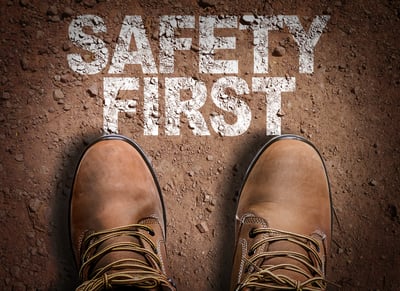 How to promote risk awareness and prevention
How to promote risk awareness and prevention
The influence of culture significantly impacts employee behaviors and attitudes about workplace safety and health. Like all other aspects of culture, success depends on leadership from the top. For ideas and actions that support safety to be widespread, they need to be embraced and practiced from the C-suite to the front line. Committed leadership and management demonstrate which behaviors will be rewarded, allowed, or punished by example.
What is safety culture?
A safety-first culture is one in which most people within the organization place high importance on safety values and behaviors. In these organizations, prioritizing safety is just how things are done. A profoundly ingrained safety culture improves workplace health, safety, and organizational performance. Some organizations refer to the "5 Cs" of safety:
- culture,
- competence,
- control,
- cooperation, and
- communication.
To assess your organization's safety culture, you might ask:
- How important is safety within daily operations?
- Do we emphasize safety some or all of the time?
- Do we cut corners on safety to save costs?
- How do we measure the effectiveness of safety guidelines and protocols?
- How often do we talk about safety?
Which Organizations Need a Safety Culture?
While the need for building safety into an organization's strategy is often associated with high-risk enterprises such as airlines, hospitals, construction projects, and military operations (often referred to as high-reliability organizations or HROs), every organization has some exposure to dangerous situations and the responsibility to protect employees and visitors. Even the most vanilla office space can experience tripping hazards, pest infestations, fires, contagious illnesses, and other threats that impact the well-being of occupants.
Cultural change can be successful in organizations of all types and sizes, and they generally involve very little financial investment. You can take eight actionable steps to solidify a culture in which safety and risk awareness are ubiquitous, which leads to better safety and lower harm.
Step 1: Communicate the Organization's Safety-related Values
While every organization wants to create a safe workplace, the details of the ideas and behaviors that are expected vary from organization to organization. Your safety-first message should clearly define whom your policies and procedures are designed to protect (i.e., employees, visitors, subcontractors, patients, customers, etc.). Safety should also be integrated into everyday activities rather than being an afterthought or something considered only when there is an extraordinary level of risk.
It is also essential that safety communication is more than just a once-and-done endeavor. Your safety-first messages can be communicated in specific health and safety policy documents, posters, daily huddles, Gemba walks, and any other consistent communication method used by your organization.
Step 2: Demonstrate Committed Leadership
To motivate and inspire every team member to work toward achieving a health and safety goal or result, leaders must demonstrate a clear and constant example. Leadership behaviors that promote a safety culture include:
- Involving staff at all levels when developing safety tools and protocols
- Wearing personal protective equipment when warranted (leading by example)
- Participating in checklist inspections
- Conducting frequent risk assessments
- Visiting the workspace to talk about health and safety
Safety leadership aims to help employees develop a sense of ownership and responsibility. The more involved people are in crafting safety policies, visual signals, and measurements, the more closely aligned they will be with the values and behaviors you want to encourage.
Step 3: Detail the Expected Behaviors
Beyond an overall commitment to workplace health and safety, team members need specific instructions on what to do and what to avoid. Everyone should know:
- What safety checks should be conducted daily
- What risks constitute a work-stopping emergency
- How to report a safety incident, danger, or opportunity for improvement
- How to access safety protocols, checklists, and instructions
- Where health and safety-related equipment is stored
Training employees about health and safety measures should be part of the employee-onboarding process and frequently continued throughout every employee's tenure.
Step 4: Make Safety Personal
People will connect more strongly with safety messages if they are relevant and connect emotionally to the individual. That's why it is important to personalize each person's role in preventing and eliminating risks and hazards.
Rather than talking about safety in vague, statistical terms, it is helpful to share stories relating to the real-world impact of safety lapses on people regarding health, financial implications, emotional challenges, and job-related stress.
Step 5: Develop Positive Safety Mindsets
Organizational culture is represented by the way things are "normally" done. If it is common for safety hazards to be overlooked, and reporting such problems leads to scorn or inaction, people will be unlikely to challenge risky behaviors in others or take proactive mitigation steps.
For this reason, it is essential to recognize and reward people who promote and enforce safety solutions. Conversely, the absence of safety protocols and policies or a lack of commitment to responding to risk makes it more challenging to develop and maintain a culture that values safety.
In a safety culture, employees firmly hold the following beliefs:
- Speaking up about safety won't negatively impact my job
- If I report a hazard, something will be done
- Reacting to safety concerns is a personal responsibility
- Safety is built into the work, not added on as an afterthought
- My safety, and that of those in my workplace, is more important than money
Step 6: Aim for a "Just Culture" Around Safety
Blaming individuals for safety incidents hinders safety culture advancement and discourages people from reporting safety events or hazards. While avoiding blame is the best response to many situations, some errors or oversights demand accountability. A solution that balances accountability without blame is the concept of a "just culture."
In a just culture, the focus is on identifying and improving systems issues that lead people to engage in unsafe behaviors while maintaining personal accountability by demonstrating zero tolerance for reckless behavior. This type of culture distinguishes between human error (i.e., falls and slips), risky behavior (i.e., taking shortcuts), and reckless behavior (i.e., purposely bypassing required safety steps). The reaction to an error or near-miss is based on the type of behavior, not the event's severity.
Step 7: Practice the 5S Workplace Organization Method
The 5S technique is most commonly used in manufacturing and warehousing organizations, but it can significantly improve safety in almost every type of workplace. The 5 S's are:
The 5 S's are:
Sort: Remove anything unnecessary for operational tasks from the workspace. Removing unnecessary items eliminates risk and makes tasks more efficient.
Set: Have a specific location where each item is stored to make it easy to find and protect its condition.
Shine: Keep equipment, tools, and the facility in working order to eliminate potential hazards. Practice regular maintenance, cleaning, and repair.
Standardize: Each space should have standards with defined ownership of each asset to make the workspace predictable.
Sustain: Once the workplace is in good order, there must be a plan for sustaining it and ensuring long-term care of the equipment, supplies, and environment.
Step 8: Implement a Safety Management System
Even if your employees have the best intentions about reporting and resolving safety concerns, you will only see results if there is a consistent and convenient way to communicate and implement safety improvements. That's why it is crucial to have a unified platform for identifying and managing safety-related opportunities for improvement. In addition to making it easy to report and act on hazards, the solution will give leaders insight into the health of safety culture. It can also be the repository for safety policies, checklists, and completed projects.
Organizational culture exists whether leadership actively shapes it or not. The vacuum is unlikely to produce a risk-free workplace if safety isn't actively promoted and recognized. These simple actions can help you begin to achieve a work environment that is healthy and safe for everyone.




Add a Comment